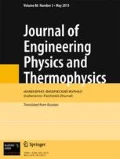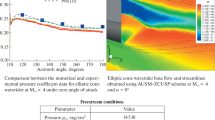Abstract
The physical aspects of the effective-adiabatic-exponent model making it possible to decompose the total problem on modeling of high-velocity gas flows into individual subproblems (“physicochemical processes” and “ aeromechanics”), which ensures the creation of a universal and efficient computer complex divided into a number of independent units, have been analyzed. Shock-wave structures appearing at entry into the duct of a hypersonic aircraft have been investigated based on this methodology, and the influence of the physical properties of the gas medium in a wide range of variations of the effective adiabatic exponent has been studied.
Similar content being viewed by others
References
V. M. Kovenya, G. A. Tarnavskii, and S. G. Chernyi, Use of the Method of Splitting in the Problems of Aerodynamics [in Russian], Nauka, Novosibirsk (1990).
G. A. Tarnavskii and S. I. Shpak, Decomposition of the methods and parallelizing of the algorithms of solution of the problems of aerodynamics and physical gas dynamics Programmirovanie, No. 6, 45–57 (2000).
Ya. B. Zel’dovich and Yu. P. Raizer, Physics of Shock Waves and High-Temperature Hydrodynamic Phenomena [in Russian], Nauka, Moscow (1966).
J. F. Clarke and M. McChesney, The Dynamics of Real Gases [Russian translation], Mir, Moscow (1967).
I. Prigogine and D. Kondepudi, Modern Thermodynamics. From Heat Engines to Dissipative Structures [Russian translation], Mir, Moscow (2002).
G. A. Tarnavskii and S. I. Shpak, An effective adiabatic index in the problems of a hypersonic real-gas flow past bodies, Teplofiz. Aéromekh., 8, No. 1, 41–58 (2001).
G. A. Tarnavskii and S. I. Shpak, Methods for calculation of an effective adiabatic index in computer simulation of hypersonic flows, Sib. Zh. Industr. Mat., 4, No. 1(7), 177–197 (2001).
G. A. Tarnavskii, Shock waves in gases with different adiabatic indices in front and behind the jump front, Vychisl. Metody Programmir., 3, No. 2, 129–143 (2002).
G. A. Tarnavskii and S. I. Shpak, Certain aspects of computer simulaiton of hypersonic flows: stability, nonuniqueness and bifurcation of numerical solution of the Navier-Stokes equations, Inzh.-Fiz. Zh., 74, No. 3, 125–132 (2001).
G. A. Tarnavskii, G. S. Khakimzyanov, and A. G. Tarnavskii, Modeling of hypersonic flows: influence of the starting conditions of the algorithm on the final solution in the vicinity of bifurcation points, Inzh.-Fiz. Zh., 76, No. 5, 54–60 (2003).
V. F. Volkov and G. A. Tarnavskii, Disturbance of symmetry and hysteresis of stationary and quasistationary solutions of the Euler and Navier-Stokes equations, Zh. Vych. Mat. Mat. Fiz., 41, No. 11, 1742–1750 (2001).
N. B. Vargaftik, Handbook on Thermophysical Properties of Gases and Liquids [in Russian], Fizmatgiz, Moscow (1963).
Yu. B. Rumer and M. Sh. Ryvkin, Thermodynamics, Statistical Physics and Kinetics [in Russian], Nauka, Moscow (1972).
G. I. Maikapar (Ed.), Non-Equilibrium Physico-Chemical Processes in Aerodynamics [in Russian], Mashinostroenie, Moscow (1972).
G. I. Mishin, A. P. Bedin, N. I. Yushchenkova, G. E. Skvortsov, and A. P. Ryazin, Anomalous relaxation and instability of shock waves in gases, Zh. Tekh. Fiz., 51, No. 11, 2315–2324 (1981).
R. W. Griffiths, R. J. Sandeman, and H. G. Hornung, The stability of shock waves in ionizing and dissociating gases, J. Phys. D: Appl. Phys., 8, 1681–1691 (1975).
T. A. Bormotova, V. V. Volodin, V. V. Golub, and I. N. Laskin, Thermal correction of the inlet diffuser of a hypersonic ramjet engine, Teplofiz. Vys. Temp., 41, No. 3, 472–475 (1975).
B. J. Gribben., K. J. Badcock, and B. E. Richards, Numerical study of shock-reflection hysteresis in a under-expanded jet, AIAA J., 38, No. 2, 275–288 (2000).
H. G. Hornung and D. W. Schwendeman, Oblique shock reflection from an axis of symmetry: Shock dynamics and relation to the Guderley singularity, J. Fluid Mech., 438, 231–241 (2001).
E. I. Vasil’ev and A. N. Kraiko, Numerical simulation of diffraction of weak shocks on the wedge under the conditions of the von Neumann paradox, in: Gas Dynamics. Selected Works [in Russian], Vol. 2, Fizmatlit, Moscow (201), pp. 235–250.
A. R. Zakharian, M. Brio, J. K. Hunter, and G. M. Webb, The von Neumann paradox in weak shock reflection, J. Fluid Mech., 422, 193–202 (2000).
S. Kobayashi, T. Adachi, and T. Suzuki, Non-self-similar behavior of the von Neumann reflection, Phys. Fluids, 12, No 7, 1869–1880 (2000).
E. Timofeev, K. Takayama, and P. Voinovich, Regular-to-Mach reflection transition on the side surface of an inclined cylinder, Numer. Exp. Study. Repts. Inst. Fluid Sci. Tohoku Univ., 11, 1–22 (1999).
H. Li and G. Ben-Dor, Analytical and experimental investigations of the reflection of asymmetric shock waves in steady flows, J. Fluid Mech., 390, 25–43 (1999).
J. D. Schmisseur and D. V. Gaitonde, Numerical investigation of strong crossing shock-wave turbulent boundary-layer interactions, AIAA J., 39, No. 9, 1742–1766 (2001).
L. F. Henderson, K. Takayama, and W. Y. Srutchfield, The persistence of regular reflection during strong shock diffraction over rigid ramps, J. Fluid Mech., 431, 273–449 (2001).
B. Sjogreen and H. C. Yee, Grid convergence of high order methods for multiscale complex unsteady viscous compressible flows, J. Comput. Phys., 185, No. 1, 1–26 (2003).
G. A. Tarnavskii, Nonuniqueness of shock-wave structures in real gases: Mach and/or regular reflection, Vychisl. Metody Programmir., 4, No. 2, 258–277 (2003).
V. Ya. Borovoy, A. Yu. Chinilov, V. N. Gusev, and I. V. Struminskaya, Interference between a cylindrical bow shock and a plane oblique shock, AIAA J., 35, No. 11, 1721–1728 (1997).
G. A. Tarnavskii, Shock-wave structures in real gases: transition between different types of interaction of shocks in the region of solution nonuniqueness, Vychisl. Metody Programmir., 5, No. 2, 219–228 (2004).
G. A. Tarnavskii, Influence of flow angularities in a hypersonic ramjet diffuser on the formation of the shock-wave structure of a real gas flow, Inzh.-Fiz. Zh., 77, No. 3, 155–164 (2004).
Author information
Authors and Affiliations
Additional information
__________
Translated from Inzhenerno-Fizicheskii Zhurnal, Vol. 79, No. 4, pp. 69–80, July–August, 2006.
Rights and permissions
About this article
Cite this article
Tarnavskii, G.A. Shock-wave flow regimes at entry into the diffuser of a hypersonic ramjet engine: Influence of physical properties of the gas medium. J Eng Phys Thermophys 79, 699–711 (2006). https://doi.org/10.1007/s10891-006-0155-5
Received:
Issue Date:
DOI: https://doi.org/10.1007/s10891-006-0155-5




